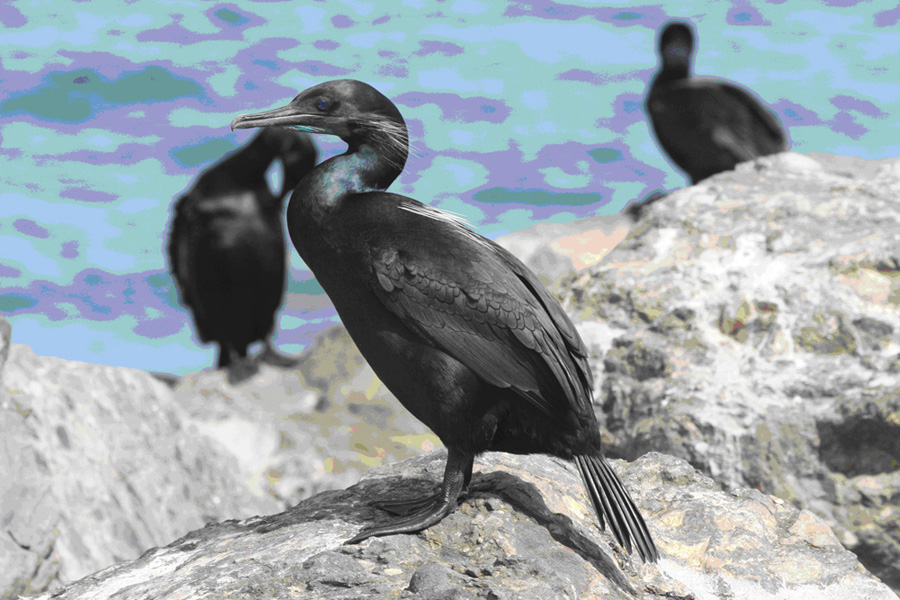
All photos for this article taken by Ron LeValley
www.LeValleyPhoto.com
The other day my grown sons and I watched a pair of Brandt’s Cormorants spread out their soaked wings to dry after a dive. Their incomplete waterproofing helps reduce buoyancy, a valuable attribute for a diving sea bird. I wonder how their parents taught them this trick.
Brandt’s Cormorants are large, black, crest-less seabirds with webbed feet, short black legs, a long neck, and a long, hooked bill that they use to catch prey while swimming underwater. Their slim bodies are 33-35 inches long and their wingspan is about four feet giving them strong, direct flight with rapid, powerful wing beats. They gather in flocks and fly to their feeding area in long straggling lines low to the waves. The cormorants depend on the rich food sources resulting from the upwelling of the California current. In the non-breeding season, the effects of this current diminish, and Brandt’s cormorant populations redistribute along the coast from South Alaska to Baja California, wintering wherever they find food locally available.
The sexes look similar. Breeding adults show brilliant turquoise eyes and a bright blue gular (throat) pouch bordered with yellow, and their face and back sport slender white plumes. This identifying mark, distinctive among cormorants, fades quickly after the nesting season. Young birds are a duller buff color on the breast.
Brandt’s Cormorants inhabit exclusively marine zones including inshore Pacific coastal waters, especially kelp bed areas, as well as large bays, estuaries, or coastal lagoons. They prefer breeding locations on gentle slopes on the windward side of coastal rocks such as the rocks north of Goat Island at the Mendocino Headlands. This species and the Pelagic Cormorant frequently nest on the same cliffs, with Brandt’s forming colonies on level ground at the cliff top and Pelagic choosing inaccessible ledges. Their colonies often include Common Murres, which nest here but so far only roost on coastal Sonoma sea-stacks such as Gualala Point Island. The feisty cormorants provide the murres with protection from marauding gulls.
Male cormorants choose the nest site and display there, exhibiting the blue throat pouch. They build a substantial nest on the ground, consisting of dry matter such as grass, sticks or rubbish and seaweed collected by diving, all cemented together by droppings.
If you watch land birds in your garden, you will notice nests with hatchlings or even fledglings by May 1 but Brandt’s Cormorants only begin building their nests at that time and take about a week to complete it. Other sea birds, such as the Western Gull, are later yet.
The female Brandt’s Cormorant lays 3-6 pale blue eggs, which hatch after a month of constant incubation into naked and helpless chicks. Nest robbing by Western Gulls presents such a serious problem that parents rarely leave eggs and chicks unguarded. Thus, both parents care for the young, feeding by regurgitation, brooding chicks when cold, and shading them from heat.
When the chicks reach about ten days old, neighboring youngsters coalesce into crèches. Older chicks then form larger groups at about one month of age. Adults still feed them but the young birds make brief sallies to the ocean where they must learn to dive. El Nino brings unusually warm waters to the eastern Pacific every few years, reducing available prey and significantly lowering populations of Brandt’s Cormorants. When panicked, adults fleeing the cramped colony trample eggs and gulls then take both eggs and young chicks. Watch Brandt’s Cormorants on Goat Island and you will see them stave off their enemies and rear their young. Given the difficulty of communicating in words with my own children, I often wonder how birds pass these skills to their offspring.

Back to ... Mendocino Coast Audubon Society Newsletter Articles | Home page